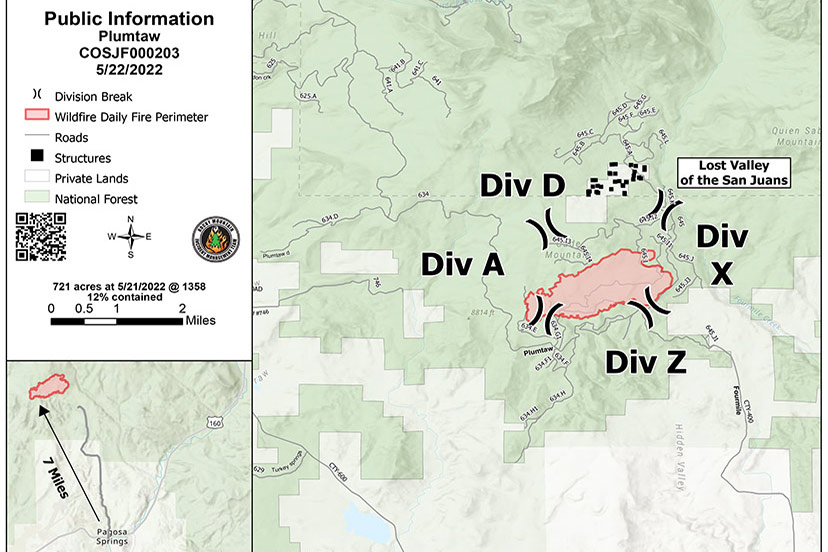Read previous Plumtaw Fire stories, beginning on May 18, here.
As they say, no news is good news. Also, no change in potentially dangerous conditions can be seen as good news.
As the sun strained to show itself through the overcast sky, on the morning of Monday, May 23, an emailed press release arrived from the Rocky Mountain Complex Incident Management Team 2. The press release was very similar to the press release from Sunday, which is something you can appreciate, when covering a wildfire.
The Plumtaw Fire, seven miles north of downtown Pagosa Springs, had not shown any growth, and remained at 721 acres. The same equipment and aircraft were being deployed. Eleven more firefighters had been added to the crew, making a total of 447.
The attached map looked identical to the map sent on Sunday. Containment had increased from 12% to 33%.
Fire activity continues to moderate as a result of cool cloudy weather and diligent work by crews. With more of the fire perimeter secured, many areas are now in patrol and in mop up status. An extensive hose lay system of over 6,000 feet with multiple pumping stations supplies water to crews while they work to extinguish lingering areas of heat. Air assets continue to be available to support crews on the ground. Fire resources and equipment will remain on scene until containment objectives are met.
Crews worked yesterday to find and extinguish hot spots and secure and improve the line; they nearly completed line construction to connect the west and east sections along the northern perimeter. The plan for Monday included ‘rehabbing hand lines’ around structures in the Lost Valley of the San Juans subdivision, ‘mopping up’, and extinguishing hot spots using portable tanks and an extensive hose-lay system.
A UAS (drone) is on order to support identifying spot fires on the northeast portion of the fire.
Weather is expected to remain cool, cloudy, and breezy through Tuesday.
Which allows me to focus the rest of this article on wildfire mitigation in general. I mentioned in Saturday’s update that I’d attended a meeting of the San Juan Headwaters Forest Health Partnership on Friday, May 20, at the Archuleta County Fairgrounds. This volunteer group meets monthly to share ideas and information about the health of the mixed-conifer forests that surround the Pagosa Springs community — and that are, in a sense, very much a part of our community. Many of us live closer to trees than to other people.
We’ve also touched on the fact that forestry professionals are using two basic approaches to making the forests ‘healthier’, working on the assumption that American forests were ‘healthier’ in their natural state… before the arrival of the timber and logging industries, and before the US Department of Agriculture and the US Forest Service began intentionally suppressing all wildfires.
Current science tells us that wildfire is a natural and necessary part of forest health. Common sense tells us that wildfire is dangerous to humans and property, when we’ve built our communities in the midst of fuel-laden forests or grasslands.
Two basic approaches are being tried to mitigate the conflict between science and common sense.
Prescribed burning. Also known as ‘controlled burning’, although the ‘controlled’ part is not always fool-proof.
And number two, mechanized removal of fuels. Sometimes known as ‘logging’. But not necessarily the same kind of logging as took place 50 years ago.
Prescribed burning — when it doesn’t get out of control — basically addresses low-growing, understory fuels that were allowed to accumulate as a result of past ‘full suppression’ forestry practices. Ideally, full-grown trees are left unharmed by a prescribed burn.
Which might suggest that prescribed burning doesn’t address the problem of ‘too many trees, too crowded together.’ Before the arrival of European immigrants in the American West, the Ponderosa pine forests of southwest Colorado typically had a lower density of trees per acres than what is common now. And that lower density made for a more fire-resistant forest.
In the following 5-minute video from 2014, we hear then-Pagosa Ranger District forester Steve Hartvigsen and then-Town Parks supervisor Jim Miller share their ideas about improved safety and forest health in Reservoir Hill Park, where a substantial tree thinning project was about to begin. (The video ends with an invitation to view additional videos on the Pagosa Daily Post, but unfortunately, those other videos are no longer available on the website.)
To obtain the type of ‘healthier forest’ described by Mr. Hartvigsen and Mr. Miller in the video, mechanized thinning is required, typically using expensive and specialized equipment. Because the thinning process entails removal of various sized trees, and because trained equipment operators need to be paid and equipment needs to be underwritten, the ideal situation would be that the logs will generate some type of profitable product.
If a thinning project can’t produce saleable products, then it has to be funded by the taxpayers, or by the private land owner.
Typically, however, the trees removed during a thinning project are smaller diameter trees that don’t always lend themselves, profitably, to sawn lumber. Other products that can be generated from small diameter trees include firewood and wood chips, but those are low-value products compared to sawn dimensional lumber.
At the San Juan Headwaters Forest Health Partnership meeting on Friday, we got an earful on the topic of mechanized thinning. Three wood products companies were in attendance: Pagosa-based Forest Health Timber Products, and two Durango-based companies, Triangle Custom Milling and Logs, and Studs Lumber Company.
How do we make this whole thing work, on the money end?

